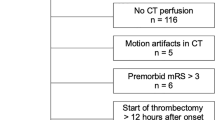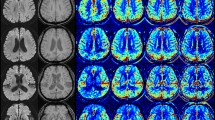Abstract
Purpose
Collateral circulation plays a pivotal role in the pathophysiology of acute ischemic stroke and is increasingly recognized as a promising biomarker for predicting the clinical outcome. However, there is no single established grading system. We designed a novel machine-learning software that allows non-invasive, objective, and quantitative assessment of collaterals according to their vascular territories. Our goal is to investigate the prognostic and predictive value of this collateral score for the prediction of acute stroke outcome.
Methods
This is a retrospective study of 135 patients with anterior circulation stroke treated with IV TPA. An equation using this collateral score (adjusting for age, baseline NIHSS, and recanalization) was derived to predict the clinical outcome (90-day mRS). The primary analyses focused on determining the prognostic value of our newly developed collateral scores. Secondary analyses examined the interrelationships between the collateral score and other variables.
Results
The collateral score emerged as a statistically significant prognostic biomarker for good clinical outcome (p < 0.033) among recanalized patients, but not among non-recanalized patients (p < 0.497). Our results also showed that collateral score was a predictive biomarker (p < 0.044). These results suggest that (1) patients with good collateral score derive more benefit from successful recanalization than patients with poor collateral score and (2) collateral status is inconsequential if recanalization is not achieved.
Conclusion
Our data results reinforce the importance of careful patient selection for recanalization therapy to avoid futile recanalization. The paucity of collaterals predicts poor clinical outcome despite recanalization. On the other hand, robust collaterals warrant consideration for recanalization therapy given the better odds of good clinical outcome.




Similar content being viewed by others
References
Fisher M, Garcia JH (1996) Evolving stroke and the ischemic penumbra. Neurology 47(4):884–888
Ryoo JW, Na DG, Kim SS, Lee KH, Lee SJ, Chung CS, Choi DS (2004) Malignant middle cerebral artery infarction in hyperacute ischemic stroke: evaluation with multiphasic perfusion computed tomography maps. J Comput Assist Tomogr 28(1):55–62
Tan JC, Dillon WP, Liu S, Adler F, Smith WS, Wintermark M (2007) Systematic comparison of perfusion-CT and CT-angiography in acute stroke patients. Ann Neurol 61(6):533–543. https://doi.org/10.1002/ana.21130
Bang OY, Saver JL, Kim SJ, Kim GM, Chung CS, Ovbiagele B, Lee KH, Liebeskind DS (2011) Collateral flow predicts response to endovascular therapy for acute ischemic stroke. Stroke 42(3):693–699. https://doi.org/10.1161/STROKEAHA.110.595256
Liebeskind DS, Jahan R, Nogueira RG, Zaidat OO, Saver JL, Investigators S (2014) Impact of collaterals on successful revascularization in solitaire FR with the intention for thrombectomy. Stroke 45(7):2036–2040. https://doi.org/10.1161/STROKEAHA.114.004781
Liebeskind DS (2005) Collaterals in acute stroke: beyond the clot. Neuroimaging Clin N Am 15(3):553–573, x. https://doi.org/10.1016/j.nic.2005.08.012
Chng SM, Petersen ET, Zimine I, Sitoh YY, Lim CC, Golay X (2008) Territorial arterial spin labeling in the assessment of collateral circulation: comparison with digital subtraction angiography. Stroke 39(12):3248–3254. https://doi.org/10.1161/STROKEAHA.108.520593
Liebeskind DS, Sanossian N (2012) How well do blood flow imaging and collaterals on angiography predict brain at risk? Neurology 79(13 Suppl 1):S105–S109. https://doi.org/10.1212/WNL.0b013e3182695904
Menon BK, d'Esterre CD, Qazi EM, Almekhlafi M, Hahn L, Demchuk AM, Goyal M (2015) Multiphase CT angiography: a new tool for the imaging triage of patients with acute ischemic stroke. Radiology 275(2):510–520. https://doi.org/10.1148/radiol.15142256
Menon BK, O'Brien B, Bivard A, Spratt NJ, Demchuk AM, Miteff F, Lu X, Levi C, Parsons MW (2013) Assessment of leptomeningeal collaterals using dynamic CT angiography in patients with acute ischemic stroke. J Cereb Blood Flow Metab 33(3):365–371. https://doi.org/10.1038/jcbfm.2012.171
Bae KT (2010) Intravenous contrast medium administration and scan timing at CT: considerations and approaches. Radiology 256(1):32–61. https://doi.org/10.1148/radiol.10090908
Aboalsamh HA, Mathkour HI, Assassa GMR, Mursi MFM (2009) Face recognition using incremental principal components analysis. Proceedings of the International Conference on Computing, Engineering and Information:39–43. doi:https://doi.org/10.1109/ICC.2009.56
Anggraini DR (2014) Face recognition using principal component analysis and self organizing maps. 2014 Third Ict International Student Project Conference (Ict-Ispc):91-94
Wang HX, Hu ZL (2006) Face recognition using probabilistic two-dimensional principal component analysis and its mixture model. Lect Notes Comput Sci 4221:337–340
European Stroke O, Tendera M, Aboyans V, Bartelink ML, Baumgartner I, Clement D, Collet JP, Cremonesi A, De Carlo M, Erbel R, Fowkes FG, Heras M, Kownator S, Minar E, Ostergren J, Poldermans D, Riambau V, Roffi M, Rother J, Sievert H, van Sambeek M, Zeller T, Guidelines ESCCfP (2011) ESC guidelines on the diagnosis and treatment of peripheral artery diseases: document covering atherosclerotic disease of extracranial carotid and vertebral, mesenteric, renal, upper and lower extremity arteries: the task force on the diagnosis and treatment of peripheral artery diseases of the European Society of Cardiology (ESC). Eur Heart J 32(22):2851–2906. https://doi.org/10.1093/eurheartj/ehr211
Gordon Perue GL, Narayan R, Zangiabadi AH, Romano JG, Rundek T, Sacco RL, Koch S (2015) Prevalence of vertebral artery origin stenosis in a multirace-ethnic posterior circulation stroke cohort: Miami Stroke Registry (MIAMISR). Int J Stroke 10(2):185–187. https://doi.org/10.1111/ijs.12321
Marks MP, Lansberg MG, Mlynash M, Olivot JM, Straka M, Kemp S, McTaggart R, Inoue M, Zaharchuk G, Bammer R, Albers GW (2014) Diffusion, perfusion imaging evaluation for understanding stroke evolution I. Effect of collateral blood flow on patients undergoing endovascular therapy for acute ischemic stroke. Stroke 45(4):1035–1039. https://doi.org/10.1161/STROKEAHA.113.004085
Fanou EM, Knight J, Aviv RI, Hojjat SP, Symons SP, Zhang L, Wintermark M (2015) Effect of collaterals on clinical presentation, baseline imaging, complications, and outcome in acute stroke. AJNR Am J Neuroradiol 36(12):2285–2291. https://doi.org/10.3174/ajnr.A4453
Miteff F, Levi CR, Bateman GA, Spratt N, McElduff P, Parsons MW (2009) The independent predictive utility of computed tomography angiographic collateral status in acute ischaemic stroke. Brain: J Neurol 132(Pt 8):2231–2238. https://doi.org/10.1093/brain/awp155
Rha JH, Saver JL (2007) The impact of recanalization on ischemic stroke outcome: a meta-analysis. Stroke 38(3):967–973. https://doi.org/10.1161/01.STR.0000258112.14918.24
Hou Q, Patrie JL, Xin W, Michel P, Jovin T, Eskandari A, Wintermark M (2017) Number needed to screen for acute revascularization trials in stroke: prognostic and predictive imaging biomarkers. Int J Stroke 12(4):356–367. https://doi.org/10.1177/1747493016677978
Lesko LJ, Atkinson AJ Jr (2001) Use of biomarkers and surrogate endpoints in drug development and regulatory decision making: criteria, validation, strategies. Annu Rev Pharmacol Toxicol 41:347–366. https://doi.org/10.1146/annurev.pharmtox.41.1.347
Menon BK, O'Brien B, Bivard A, Spratt NJ, Demchuk AM, Miteff F, Lu X, Levi C, Parsons MW Assessment of leptomeningeal collaterals using dynamic CT angiography in patients with acute ischemic stroke. J Cereb Blood Flow Metab 33(3):365–371
Author information
Authors and Affiliations
Corresponding author
Ethics declarations
Funding
This study was funded by RSNA Research Resident Grant no. RR1570 and NIH T32 Grant no. T32EB001631.
Conflict of interest
The authors declare that they have no conflict of interest.
Ethical approval
All procedures performed in studies involving human participants were in accordance with the ethical standards of the institutional and/or national research committee and with the 1964 Helsinki declaration and its later amendments or comparable ethical standards.
Informed consent
Informed consent was obtained from all individual participants included in the study.
Rights and permissions
About this article
Cite this article
Tong, E., Patrie, J., Tong, S. et al. Time-resolved CT assessment of collaterals as imaging biomarkers to predict clinical outcomes in acute ischemic stroke. Neuroradiology 59, 1101–1109 (2017). https://doi.org/10.1007/s00234-017-1914-z
Received:
Accepted:
Published:
Issue Date:
DOI: https://doi.org/10.1007/s00234-017-1914-z




